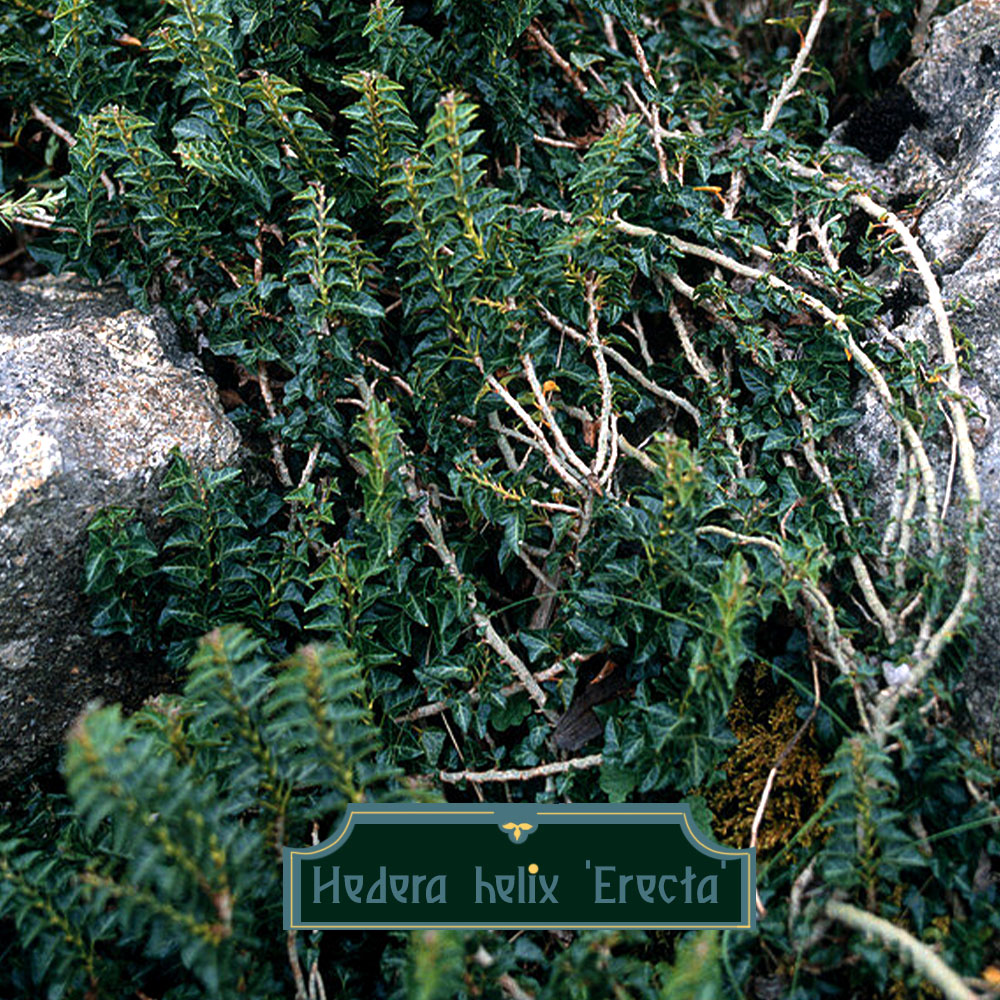No products in the cart.
Hedera helix Erecta
An unusual stately candelabra ivy
Rated 0 out of 5
0 customer reviews
4,90 €
Only 14 item(s) left in stock!
Tags: chaud, couleur, couvre sol, evergreen, feuillage persistant, graphique, perennial, potted plant, secheresse, vivace, vivace en pot, xeriscaping
SKU: pda337
Category: Balcony-Friendly, Bouquet, Evergreen, Frost Hardy, Ground Cover, Rewild

Hedera helix Erecta
4,90 €
Only 14 item(s) left in stock!
Hedera helix Erecta is a mutation of common ivy, notable for its striking structure of erect, candelabra-like growth and its small, geometrically arranged leaves.
Hedera helix Erecta is a moderately fast-growing shrub that forms an attractive clump about 1 meter wide and tall.
The leaves are small and triangular, arranged alternately and symmetrically on thick, upright stems, shifting from a soft light green to dark grayish as they age.
Each leaf is contrasted by pale veins, giving it a marbled appearance.
In autumn, its small and inconspicuous green flowers form globular clusters and provide excellent nectar for bees. These are followed by bluish-black berries, toxic to humans but an excellent winter food source for birds.
👨🌾GARDENING TIPS👨🌾: Hedera helix Erecta
-
- ☀️ Hederas are plants of the forest shade – avoid planting ‘Erecta’ in an overly hot, sun-exposed areas.
- Afternoon shade or sheltered beneath a tree canopy will allow it to thrive – it is otherwise perfectly hardy and drought-resistant
- ⭐ Planting it alongside flowering perennials that tend to flop – Gaura / Echinacea / Phlox / Verbena – will allow for the ‘Erectas’ to hold your composition for longer
- Can be used as a low hedge or border and requires little maintenance
- 🫖 Looks very striking in a large container as a feature on a terrace or balcony
- ☀️ Hederas are plants of the forest shade – avoid planting ‘Erecta’ in an overly hot, sun-exposed areas.
The Tale: Hedera helix Erecta
Ivies belong to the Araliaceae family, making them relatives of Ginseng and Fatsia.
Hedera helix is a family that naturally produces mutations, that are isolated by botanists or plant nursery owners and published in a recognized journal – the RHS yearly cultivar publication for instance.
‘Erecta’ is a natural mutation of the botanical variety found in gardens and forests across the entire temperate Eurasian zone of the Northern Hemisphere.
Any and all varieties of ‘Erecta’ are cuttings of the original mutation as cross-pollination is exceedingly difficult within the Hedera family. The experiments often result in the mutation reverting to its botanical base, losing all of its peculiar particularities.
Ivy is so interesting – check out our partner website – www.lierres.com – where I currently also work as watchful guardian and caretaker of the largest ivy collection in the world
Origin:
Europe
| Weight | 0,2 kg |
|---|---|
| Flowering | September, October |
| Exposure | Half Sun/Half Shade |
| Frost Tolerance | -20°C to -25°C |
| Size | 1m H x 1m W |
| Soil | Any |
Reviews
0
Rated 0 out of 5
0 customer reviews
5
0
4
0
3
0
2
0
1
0
Only logged in customers who have purchased this product may leave a review.
You may also like…
Anthemis tinctoria E.C. Buxton
Lemon yellow daisies atop soft, ferny leaves
Lemon yellow daisies atop soft, ferny leaves
Rated 0 out of 5
Phlox amplifolia
A tall plant with large fragrant and edible flowers
A tall plant with large fragrant and edible flowers
Rated 0 out of 5
Gaura lindheimeri – Oenothera lindheimeri
Known for its long blooming season, its superb white or pink flowers and its airy stature.
Known for its long blooming season, its superb white or pink flowers and its airy stature.
Rated 0 out of 5
Verbena bonariensis
Long stalks with light, floating purple specks that attract bees
Long stalks with light, floating purple specks that attract bees
Rated 0 out of 5
Related Products
Stachys byzantina
Silky white-grey leaves and tall striking flowers
Silky white-grey leaves and tall striking flowers
Rated 0 out of 5
Artemisia Valerie Finnis
A semi-evergreen, aromatic variation on the theme of Artemisia.
A semi-evergreen, aromatic variation on the theme of Artemisia.
Rated 0 out of 5
Sedum album
A low, multi-color ground cover.
A low, multi-color ground cover.
Rated 0 out of 5
Trachelospermum asiaticum ‘Ogon Nishiki’
Jasmine with colorful foliage and lovely white flowers in summer
Jasmine with colorful foliage and lovely white flowers in summer
Rated 0 out of 5
Euphorbia myrsinites
Known for its draping form of silver-gray foliage and radiant blooms.
Known for its draping form of silver-gray foliage and radiant blooms.
Rated 0 out of 5
Euphorbia cyparissias Clarice Howard
A Euphorbia that resembles a soft little cyprus tree
A Euphorbia that resembles a soft little cyprus tree
Rated 0 out of 5
Echinacea purpurea
A perennial with purple flowers all summer long
A perennial with purple flowers all summer long
Rated 0 out of 5
Mentha x piperita ‘Chartreuse’
A spicy mint, known for its use in the production of liqueurs and herbal teas.
A spicy mint, known for its use in the production of liqueurs and herbal teas.
Rated 0 out of 5
Cerastium tomentosum var. columnae
A grey-green spreading ground cover from the mountains.
A grey-green spreading ground cover from the mountains.
Rated 0 out of 5
Hieracium maculatum Leopard
A native perennial with blue-green leaves and a tall yellow flower
A native perennial with blue-green leaves and a tall yellow flower
Rated 0 out of 5
Glechoma hederacea
A sweet smelling ground cover, producing little blue flowers all summer long.
A sweet smelling ground cover, producing little blue flowers all summer long.
Rated 0 out of 5
Delosperma cooperi
A dwarf perennial known for its vermillion colored flowers
A dwarf perennial known for its vermillion colored flowers
Rated 0 out of 5
Vinca minor
Looping elegance and ability to form a low flowering ground cover
Looping elegance and ability to form a low flowering ground cover
Rated 0 out of 5
Melissa officinalis
A perennial plant in the mint family that is adored by bees, royal families and tea drinkers.
A perennial plant in the mint family that is adored by bees, royal families and tea drinkers.
Rated 0 out of 5
Kalanchoe daigremontiana
A toothy succulent from Madagascar, known as the Mother of Thousands.
A toothy succulent from Madagascar, known as the Mother of Thousands.
Rated 0 out of 5
Erigeron kavinskianus
A daisy-like carpet of flowers
A daisy-like carpet of flowers
Rated 0 out of 5
Hellebore argutifolius
Winter flowering perennial with marbled blue-green leaves
Winter flowering perennial with marbled blue-green leaves
Rated 0 out of 5
Tradescantia Blushing Bride
Gorgeous blushes of pink and white that appear in the coldest nights.
Gorgeous blushes of pink and white that appear in the coldest nights.
Rated 0 out of 5
recent view product
Alcea rosea ‘Chater’s Double Apricot’
Giant 2m tall apricot colored flowers
Giant 2m tall apricot colored flowers
Rated 0 out of 5
Mentha x piperita ‘Chartreuse’
A spicy mint, known for its use in the production of liqueurs and herbal teas.
A spicy mint, known for its use in the production of liqueurs and herbal teas.
Rated 0 out of 5
Mentha suaveolens ‘Calixte’
A yellow-green dappled variation of the fuzzy mint.
A yellow-green dappled variation of the fuzzy mint.
Rated 0 out of 5
Trachelospermum asiaticum ‘Ogon Nishiki’
Jasmine with colorful foliage and lovely white flowers in summer
Jasmine with colorful foliage and lovely white flowers in summer
Rated 0 out of 5
Salvia officinalis ‘Bergartten’
Salvia officinalis ‘Bergartten’ is a variety of sage that is prized for its large, round silver-blue leaves and soft blooms in the summer.
Salvia officinalis ‘Bergartten’ is a variety of sage that is prized for its large, round silver-blue leaves and soft blooms in the summer.
Rated 0 out of 5

















































There are no reviews yet.